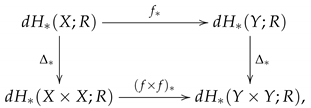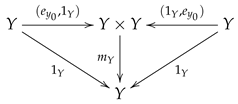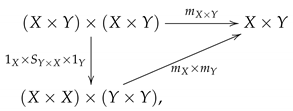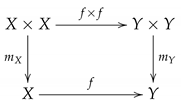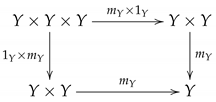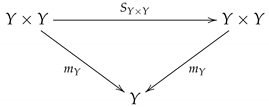1. Introduction
1.1. History and Hopf Space
Digital geometry deals with bounded and finite discrete sets in the sense of classical topology, which is considered to be digital images or digitalized models of bounded and finite subsets of the lattice points in Euclidean space. The homology modules, higher homotopy groups, stable homotopy groups and equivariant homotopy groups are useful algebraic and topological tools to solve a large number of problems of algebraic geometry and algebraic topology. In the same lode, the digital counterparts of classical homology modules can be important gadgets to classify (pointed) digital images from the point of view for the digital version of the homotopy type, mathematical morphology, and image synthesis. In particular, the informal definitions of many terms in elementary homotopy and simplicial homology theory based on a digital picture on
or
were nicely presented in [
1,
2,
3,
4,
5]; see also [
6] for digital quasi co-Hopf spaces.
In the 20th century, a lot of interesting and remarkable results on Lie groups and (pointed) Hopf spaces, as the Eckmann–Hilton dual notions of (pointed) co-Hopf spaces, have been widely investigated and suitable methods have been developed for CW-spaces and usual topological spaces. The (pointed) Hopf spaces were the direct outgrowth of compact Lie groups in classical homotopy theory, as described in [
7,
8,
9]. Indeed, a pointed Hopf space is a triple
which consists of a pointed topological space
and a base point preserving continuous multiplication
such that a constant function
at
plays a role of a homotopy identity, i.e.,
for all
in the pointed homotopy category. The notion of (pointed) Hopf spaces is one of the Eckmann–Hilton dual notions of a co-Hopf space; see [
10,
11,
12,
13,
14,
15,
16,
17,
18,
19,
20,
21,
22] for topics related to those basic notions. It can be seen that all (pointed) Lie groups are (pointed) Hopf spaces. In general, the Hopf spaces lack associative and inversive properties and do not have the structure of usual topological manifolds at all.
Multiplication in a Hopf space provides the homology modules of a Hopf space with an algebraic structure which is natural with respect to Hopf functions. In fact, we can construct the algebra structure at homology level which is called as the Pontryagin algebra of the Hopf space. Under suitable conditions, the diagonal function gives the non-negatively graded homology module a coalgebra structure. The two algebraic structures are related to each other and covert the non-negatively graded homology modules into a classical Hopf algebra.
1.2. Motivation
There are a few standard approaches for considering a digital analogue of the well-known usual topology on
such as the graph-theoretic approach, the imbedding approach, and the axiomatic approach [
23]. From this point of view, we need to investigate another approach to study digital topology out of classical algebraic topology. In the present paper, we introduce another consideration of a digital analogue as the so-called algebraic approach from the classical homology and Pontryagin algebra. More precisely, the current study is concerned with setting up more algebraic invariants and their fundamental properties of digital homology modules over a commutative ring with identity for digital image with an adjacent relation which are based on the classical homology groups of topological spaces in mathematics and computer science.
1.3. Organization of the Paper
The current paper has been organized as follows. In
Section 2, we introduce the general notions of digital images with
-adjacent relations. In
Section 3, we consider a digital
n-simplex, digital
n-chains, and digital homology modules over a commutative ring
R with identity of digital images. We also investigate some fundamental and interesting properties of digital homology modules and primitive homology classes of digital images. In
Section 4, we consider a pointed digital Hopf space together with digital multiplications, digital homotopy associative and commutative multiplications, and base point preserving digital Hopf functions between pointed digital Hopf spaces with digital multiplications based on pointed digital sets. We also explore important properties of digital primitive homology classes and digital Pontryagin algebras in digital Hopf spaces as a symmetric phenomenon [
24] in mathematics and computer science.
2. Preliminaries
Let be the ring of integers and the field of all real numbers. Let be the set of all lattice points in the n-dimensional Euclidean space . A digital image is a pair , where X is a bounded and finite subset of and indicates some adjacent relation between the members of X; see below.
For an integer u with , we will first define an adjacent relation of a digital image in as follows.
Definition 1 ([
25])
. Two points and with in are -adjacent if- (1)
there are at most u distinct indices i with the property ; and
- (2)
if , then for all indices j.
A -adjacency relation on may be denoted by the number of points that are -adjacent to a point . Moreover,
the -adjacent points of are called 2-adjacent; and
the -adjacent points of are called 4-adjacent, and the -adjacent points in are called 8-adjacent.
We mostly denote -adjacent relation on a digital image X by -adjacent relation for short if there is no chance of ambiguity.
Definition 2 ([
26,
27])
. A digital image in is said to be -connected if for every pair of points with , there exists a set of distinct points such that , and and are -adjacent for . The following is a minor modification of an earlier definition of a digital continuous function given in [
27] (Definition 2.3); see also [
28].
Definition 3. Let and be digital images with -adjacent and -adjacent relations, respectively. A function from to is said to be a -continuous function if the image of every -connected subset of digital image X under f is a -connected subset of Y.
Let , and be digital images. If is a -continuous function and is a -continuous function, then it is not difficult to show that the composite of f and g is -continuous. Thus, it is possible to construct the category of digital images and digital continuous functions; that is, the object classes of are digital images and the morphism classes are digital continuous functions.
Definition 4 ([
25,
27,
29])
. Let and be digital images with -adjacent and -adjacent relations, respectively, and let be -continuous functions. Suppose that there is a positive integer m and a -continuous function such that and for all ;
the induced function defined by for all is -continuous; and
the induced function defined by for all is -continuous.
Then, F is called a digital -homotopy between f and g, written as , and f and g are called digitally -homotopic in Y.
We note that an adjacent relation on the cartesian products in Definition 4 has been used as the so-called generalized normal product adjacency relation. We now describe the pointed versions of digital images to develop the pointed digital category as follows.
Definition 5 ([
30,
31])
. A pointed digital image with -adjacent relation is a triplet , where X is a digital image and . In this case, is said to be a base point of . A pointed digital continuous functionis a -continuous function from to such thatA digital homotopybetween pointed digital continuous functions f and g is said to be pointed digital -homotopy between f and g if for all . We now construct the so-called pointed digital category of pointed digital images and base point preserving digital continuous functions; that is, the object classes of are pointed digital images and the morphism classes are base point-preserving digital continuous functions.
3. Digital Homology Modules
In this section, we consider the digital homology modules [
32,
33] over a commutative ring
R with identity ‘
’ (compare with [
4] in the case of digital simplicial homology groups).
For
, we let
be the point in
having coordinates all zeros except for 1 in the
-th coordinate; that is,
,
, …, and
in
. As a special case of an affine combination in topological geometry, a digital convex combination of points
in
is a point
x with
where
, and
or 1. Here, the numbers
are said to be the barycentric coordinates of the point
x.
Unlike the classical convex combination of points, it can be easily verified that x is a digital convex combination of if and only if x is an element of . We let be the set of all digital convex combinations of points in ; that is, , which is completely different from the usual convex combinations in algebraic topology when . Considering as the digital image with -adjacent relation, we can see that it is -connected, and we call a digital standard n-simplex. We denote the -adjacent relation in the digital image by for our notational convenience, as mentioned earlier.
A digital
n-simplex in a digital image
with
-adjacent relation is a
-continuous function
where
is the digital standard
n-simplex.
Let R be a commutative ring with identity and let be a digital image with -adjacent relation. For each , we define to be the non-negatively graded free R-module with basis all digital n-simplexes in . The elements of are called digital n-chains in .
For each
n and
i, we now define the
i-th face function
as the function which would send the ordered vertices
to the ordered vertices
preserving the displayed orderings as follows:
; and
for ,
where the numbers are the barycentric coordinates of a point of or .
Let
be a digital image with
-adjacent relation, and let
be a digital
n-simplex in
. Then, the map
defined as
is called the digital boundary operator of the digital image
. It can be seen in [
32] that
for all
.
The kernel of is called the module of digital n-cycles in and denoted by . The image of is called the module of digital n-boundaries in and denoted by . We note that is a submodule of for each .
The
n-th digital homology module
over
R of a digital image
with
-adjacent relation is defined by
for each
, The coset
is called the digital homology class of
, where
is a digital
n-cycle; see [
32] for more details.
Let
be the first inclusion, and
be the second inclusion, then we have
R-module homomorphisms
of digital homology modules induced by
and
, respectively.
We note that
plays a role of a bridge between the digital world in computer science and the algebra world in mathematics; see
Figure 1.
Definition 6. An element is said to be a digital primitive homology class ifwhere is the diagonal map. Let denote the submodule of with coefficients in a commutative ring R with identity consisting of all the digital primitive homology classes. Then, we have the following.
Proposition 1. Let be a -continuous function. Then Proof. If
x is any digital primitive homology class of
with coefficients in the commutative ring
R with identity
, then from the commutative diagram
we have
where
is the first inclusion and
is the second inclusion on
or
Y; that is, the homomorphic image of the digital primitive homology classes is also digital primitive, as required. □
4. Digital Hopf Spaces and Pontryagin Algebras
From many kinds of algebraic structures in mathematics, we can think of a Hopf group in algebraic topology as a generalization of a usual group in algebra (see [
34,
35]). For application in computer science, the notions of Hopf spaces or Hopf groups in mathematics will be transformed in this section to those of digital theoretical counterparts in computer science (compare with [
36,
37]).
Definition 7 ([
30,
31])
. Let be a constant function at and let be an identity function on Y. A digital Hopf space (sometimes denoted as for short) consists of a pointed digital image with an adjacent relation and a -continuous function so that the following diagramis commutative up to pointed digital homotopy. Here, is an adjacent relation on , and is the composite of the diagonal function with the product of functions , and similarly for . In this case, the -continuous function above is called a digital multiplication on , and is called a digital homotopy identity. As usual, we denote the pointed digital homotopy class by as the equivalence class of a pointed digital continuous function .
Definition 8 ([
30,
31])
. Let be a digital Hopf space with a digital multiplicationFor pointed -continuous functionswe define a digital convolution between pointed digital homotopy classes and by the pointed digital homotopy class of the following compositionsthat is,where Δ
is a diagonal function. We now have a symmetric phenomenon in algebra from a digital Hopf space as follows.
Theorem 1. Let be a digital Hopf space with a digital multiplication . If are -continuous functions and , thenwhere are homomorphisms of digital homology modules over R induced by -continuous functions f and g, respectively. Proof. We note that
and the following diagram
is strictly commutative, and similarly for
together with
in digital homology
R-modules. Since
Y has the digital Hopf structure and
x is a digital primitive homology class, we have
where
is the identity map. □
The
Figure 2 is a symmetric phenomenon derived from Theorem 1:
The following shows that the digital Hopf spaces are closed under the digital products of digital images; that is, the digital Hopf spaces are well behaved with respect to the cartesian products.
Theorem 2. If and are digital Hopf spaces, then is a digital Hopf space.
Proof. Let
and
be the digital multiplications on
X and
Y, respectively. We define a function
by making the following diagram commute:
where
is a switching function, and
and
are the identity functions on
X and
Y, respectively. Then, for all
, we have
that is,
Similarly, we also obtain
Therefore,
is a digital multiplication, that is,
is a digital Hopf space. □
Corollary 1. Let be a digital Hopf space and letbe the first and second inclusions, respectively. Then we obtainand, in particular, Proof. Let
be the digital multiplication on
. Then, from Theorem 2,
is also a digital Hopf space with a digital multiplication
. Since
and
we have
where
is the switching function. If
y is any digital primitive homology class, then, from Theorem 1, we obtain
as required. □
Definition 9. Let and be pointed digital Hopf spaces. A -continuous function is said to be a digital Hopf function if the following diagramcommutes up to the digital homotopy. Definition 10. The digital homology cross product is defined by the homomorphismof R-modules sending to . Under what conditions can we say that the submodule consisting of digital primitive homology classes is equal to ? The following gives an answer to this query:
Theorem 3. Let for . Then is equal to for all .
Proof. We consider the Künneth exact sequence
of
R-modules in algebraic topology; see [
34] (p. 228). We note that the Künneth formula is still valid for digital homology modules over a commutative ring with identity
because it is purely algebraic. If
, then, by our assumption, the torsion part in the above short exact sequence is trivial, so that the cross product is an isomorphism of
R-modules. We now consider a homomorphism of
R-modules
for all
induced by the diagonal map
We see that the target of the
R-module homomorphism
is isomorphic to the first term of the Künneth exact sequence (
1). Therefore, for all
, we have
for each
; that is,
is a digital primitive homology class, as required. □
Example 1. Let be a digital image in with the 8-adjacency relation. Then it can be shown that Moreover, if , thenthat is, Let
be a digital Hopf space with a digital multiplication
. Then, the homomorphism
between digital homology modules with coefficients in a commutative ring
R with identity
gives an algebraic structure on the digital homology
.
Definition 11. Let be a digital Hopf space with a digital multiplication . Then the above algebraic structure on the digital homology is called the digital Pontryagin R-algebra of the digital Hopf space .
Definition 12 ([
30,
31])
. A digital multiplication on a digital Hopf space is said to be digital homotopy associative if the following diagramis digital homotopy commutative. A digital Hopf space with a digital multiplication is said to be a digital homotopy associative Hopf space if is digital homotopy associative. Definition 13 ([
30,
31])
. Letbe a switching function. A digital multiplicationis said to be digital homotopy-commutative if the following diagramis commutative up to digital homotopy. A pointed digital Hopf space with a digital multiplication is said to be a digital homotopy commutative Hopf space if is digital homotopy commutative. For a specific example, see [
31] [Example 3.8].
We note that if
is a digital Hopf space with a digital multiplication
, then, by Theorem 2,
induces a homomorphism
of digital homology modules over a commutative ring
R with identity
.
Theorem 4. Let be a digital homotopy associative and commutative Hopf space with a digital multiplication . Then the digital Pontryagin R-algebra becomes a non-negatively graded associative and commutative R-algebra.
Proof. Let
be the digital homology cross product. Then, we can consider the composite
of
R-module homomorphisms, which we denote by ‘
’ or ‘
’. Since the digital multiplication
is digital homotopy associative, we can see that the following diagram
commutes on digital homology
R-modules. Moreover, the digital homotopy commutative multiplication
induces the following commutative diagram
on digital homology
R-modules, where
is an
R-module homomorphism induced by the switching map
. Therefore,
is a graded associative and commutative
R-algebra. □
Example 2. Let be the digital image in with the 8-adjacency relation as in Example 1. Then is a digital homotopy associative and commutative Hopf space having a digital homotopy inverse, where and (see [31] [Example 3.8]). Since has a digital multiplicationthe algebra structure on makes it into the digital Pontryagin R-algebra. Moreover, Theorem 4 asserts that the digital Pontryagin R-algebra is a non-negatively graded associative and commutative R-algebra. In particular, if R is a field, then is a non-negatively graded vector space of the field R in which we can sometimes use the dimensional issues. Theorem 5. Let be a digital Hopf function between digital Hopf spaces. Then is an R-module homomorphism of the digital Pontryagin R-algebras.
Proof. We need to show that
and
for all
r in
R and
in
. Since it is not difficult to show that the first and second conditions are satisfied, we will only check the final condition. From the following commutative diagram
of
R-modules, we have
as required. □
Example 3. Let be the digital image in with the 8-adjacency relation as in Example 1, and letbe the identity function. Then f is a digital Hopf function and the mapinduced by f is an R-module automorphism of digital Pontryagin R-algebras. Remark 1. Let be the category of pointed digital homotopy associative and commutative Hopf spaces and digital Hopf functions and let be the category of non-negatively graded associative and commutative R-algebras and R-algebra maps. Then, Theorems 4 and 5 assert thatis a covariant functor. 5. Conclusions
Hopf spaces and co-Hopf spaces play a pivotal role in algebraic topology, especially in (equivariant) homotopy theory in mathematics. Digital topology deals with the so-called discrete sets with a topology in the sense of Euclidean topology, which is considered to be digital sets or images of finite and bounded subsets of the n-dimensional Euclidean space. In digital topology, the digital process substitutes a bounded and finite discrete set for a suitable object in some category.
In the current study, we have developed the concept of a digital counterpart of classical notions in mathematics using the so-called algebraic approach from the classical homology and Pontryagin algebra. More specifically, this study focused on setting up more algebraic invariants and their fundamental properties of digital homology modules over a commutative ring with identity for a digital image with an adjacent relation which are based on the classical homology groups of topological spaces as a symmetric phenomenon in mathematics and computer science.
